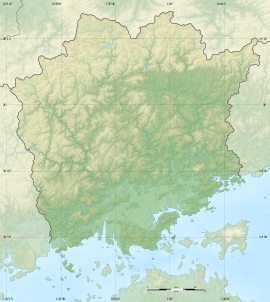| Tsuyama Castle | |
|---|---|
津山城 | |
| Tsuyama, Okayama Prefecture, Japan | |
 | |
| Coordinates | 35°3′45.97″N 134°0′17.83″E / 35.0627694°N 134.0049528°E |
| Type | Teikaku-style hirayama castle |
| Height | (five stories) |
| Site information | |
| Controlled by | Yamana clan (1441–), Mori clan (1603–1697), Matsudaira clan (1698–1871), Japan (1873–present) |
| Condition | Mostly ruins, Bitchū-yagura reconstructed in 2005. |
| Site history | |
| Built | 1441–1444; major expansions 1603–1616 |
| Built by | Yamana clan (original); Mori Tadamasa (1603) |
| In use | 1616–1873 |
| Materials | stone, wood, plaster walls |
| Demolished | 1874–1875 |


Tsuyama Castle (Japanese: 津山城, Hepburn: Tsuyama-jō) is a Japanese castle located in the Sange neighborhood of the city of Tsuyama, Okayama Prefecture, in the San'in region of Japan. Tsuyama considered one of Japan's three major hirayama (平山城 hilltop) style castles along with Himeji Castle and Matsuyama Castle, which were all constructed around the same time. During the Edo period, Tsuyama castle served as the primary residence of the daimyō of the Tsuyama Domain under the Tokugawa shogunate. The castle was also called Kakuzan Castle (鶴山城, Kakuzan-jō). It has been protected by the central government as a National Historic Site since 1963.[1]

